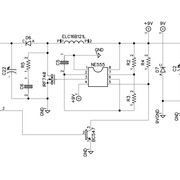sonolink
Well-known member
Hi everybody,
I'm trying to "convert" a through hole layout to SMD and don't know what footprint to use with some components in a PSU. Could someone advise me please?
This is the PSU schem:

I'll be substituting resistors and caps with 0805 SMD footprint when possible (not the big electrolytics, of course). The components I don't know what hand solderable SMD footprint to use with are the following:
-100uH inductor
-7806 Voltage Regulator
-NE555 clock
-50mA self resetting polyfuse
-IRF740
Also, does anyone know what I could use to substitute these, please? They're for a cabsim.
BC547, BC337, BC327, TL072
Thanks a lot for your time and help
Cheers
Sono
I'm trying to "convert" a through hole layout to SMD and don't know what footprint to use with some components in a PSU. Could someone advise me please?
This is the PSU schem:

I'll be substituting resistors and caps with 0805 SMD footprint when possible (not the big electrolytics, of course). The components I don't know what hand solderable SMD footprint to use with are the following:
-100uH inductor
-7806 Voltage Regulator
-NE555 clock
-50mA self resetting polyfuse
-IRF740
Also, does anyone know what I could use to substitute these, please? They're for a cabsim.
BC547, BC337, BC327, TL072
Thanks a lot for your time and help
Cheers
Sono






![Electronics Soldering Iron Kit, [Upgraded] Soldering Iron 110V 90W LCD Digital Portable Soldering Kit 180-480℃(356-896℉), Welding Tool with ON/OFF Switch, Auto-sleep, Thermostatic Design](https://m.media-amazon.com/images/I/41gRDnlyfJS._SL500_.jpg)

























